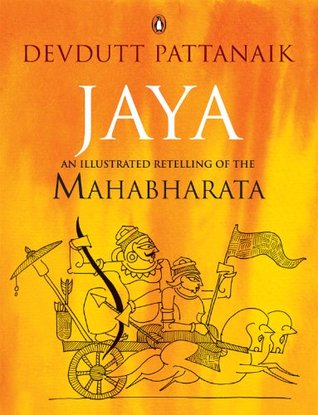More on this book
Community
Kindle Notes & Highlights
Started reading
April 7, 2016
married and enabling his father to shun retirement. Thus, for all their nobility, the two generals of the Kaurava army are responsible for the breakdown of dharma as much as Duryodhana.
Arjuna should not assume that words spoken under stressful situations were real. His brother was just angry and did not mean to insult him or his bow. One should have faith in one’s friends and family and not let one harsh word break the bond of trust.
Dindigul, where Draupadi is worshipped as a goddess, processions enacting various episodes of the Mahabharata are taken out over eighteen days of the Draupadi Amman festival.
The story of Gandhari’s failed attempt to make her son invulnerable to weapons is similar to the Greek tale of the sea nymph Thetis dipping her son Achilles in the river Styx, so that most of his body except the part she held—his ankles—became impervious to weapons.
Tamil Nadu, the eighteen-day war is ritually enacted during the Terukkuttu performance, in which a giant image of Duryodhana lying on the ground is made out of the earth. On the right thigh is placed a pot full of red fluid. This pot is smashed at the end of the performance by the actor playing Bhima who goes into a frenzied trance.
Duryodhana is worshipped as a benevolent deity in Har-Ki-Doon Valley in Uttarakhand. Wooden temples dedicated to the epic villain are found there.
Many scholars believe that the description of the weapons released by Ashwatthama and Arjuna suggest that the Rishis of ancient times were familiar with, or at least visualized, nuclear weapons.
Pandavas are willing to change; they want to outgrow the beast within them. The process of change is difficult—the Pandavas have to suffer exile, kill loved ones and lose their children, in the process of gaining wisdom. The Kauravas cling to their kingdom like dogs clinging to a bone. They refuse to change. Hence, they die without learning anything. Krishna is the teacher. But the onus of learning rests with the students.
No one can escape death. The point is to make the most of life—enjoy it, celebrate it, learn from it, make sense of it, share it with fellow human beings—so that when death finally comes, it will not be such a terrible thing.’
‘A hermit seeks meaning for himself but only a king can create a world that enables everyone to find meaning.
‘Life is like a river. You can struggle to change its course but ultimately it will go its own way. Bathe in it, drink it, be refreshed by it, share it with everyone, but never fight it, never be swept away by its flow, and never get attached to it. Observe it. Learn from it.’
Ram requests Ravana, his learned opponent, to share his wisdom before he dies. In the Mahabharata, the Pandavas request Bhishma to share his wisdom. The idea behind both episodes is that, unlike wealth, knowledge does not outlive death, hence has to be passed on to the living so that it is not lost forever.
observe Bhishma Ekadashi on the eleventh day of the waxing moon in the month of Magh (Jan–Feb) to mark the occasion when the Vishnu Sahasranama was revealed to the Pandavas.
B.N. Narahari Achar has determined the date of the war using Planetarium software, beginning with Krishna’s journey to Hastina-puri and ending with Bhishma’s death. He concludes that Krishna left on 26 Sep 3067 BCE, reaching Hastina-puri on 28 Sep and leaving Karna on 9 Oct. A solar eclipse occurred with the new moon on 14 Oct, with Saturn at Rohini and Jupiter at Revati exactly as given in the epic. The war began on 22 Nov 3067 BCE. Bhishma expired on 17 Jan 3066 BCE (Magh Shukla Ashtami), the winter solstice occurring on 13 Jan 3066. It must be kept in mind that 5000 years ago, the date of
...more
In Prabhas Patan, on the sea coast of the state of Gujarat, stands a tree that has been identified as the descendant of the Banyan tree under which Krishna was fatally injured.
Life would continue, with joys and sorrows, triumphs and tragedies rising and falling like the waves of the sea. It was up to him to respond wisely, enjoy simple pleasures unshaken by the inevitable endless turmoil of the world.
Archaeologists have found traces of an ancient port city in the coast near modern Dwaraka dated to 1500 BCE, the time when a great city-based civilization thrived on the banks of the Indus across what is today
images of Krishna based on descriptions given by Abhimanyu’s wife, Uttari. But the description was so grand that each artisan could capture only part of the beauty in each image. These images were lost to the world for centuries and later discovered by holy men who enshrined them in temples. The image of Srinathji at Nathdvara is said to be one such image.
The epic ends not with the victory of the Pandavas over the Kauravas but with Yudhishtira’s triumph over himself. This is spiritual victory or Jaya. This is the ultimate aim of the great epic.
‘There are two kinds of victory in this world,’ said the storyteller-sage, ‘Vijaya and Jaya. Vijaya is material victory, where there is a loser. Jaya is spiritual victory, where there are no losers. In Kuru-kshetra there was Vijaya but not Jaya. But when Yudhishtira overcame his rage and forgave the Kauravas unconditionally, there was Jaya. That is the true ending of my tale, hence the title.’
the point of existence is not to accumulate merit, but to attain wisdom. We have to ask ourselves—why do we do what we do? When we truly accept the answer, we break free from the cycle of births and deaths, and
Let us all have faith. Let us all be at peace—with ourselves, our worlds, and all the rest there is. Shanti. Shanti. Shanti.


